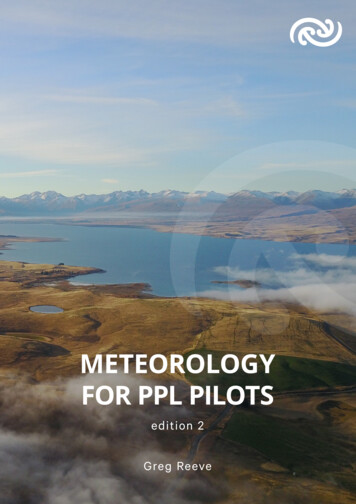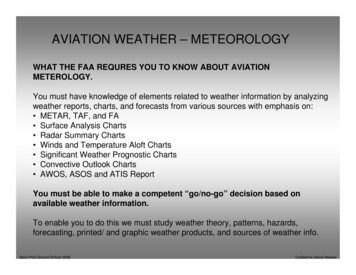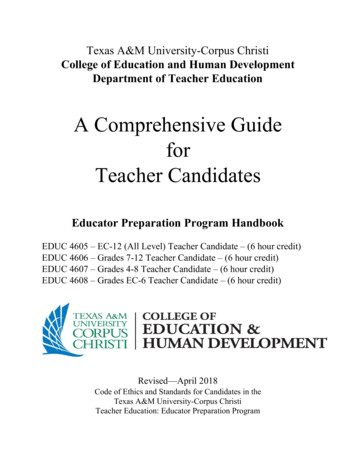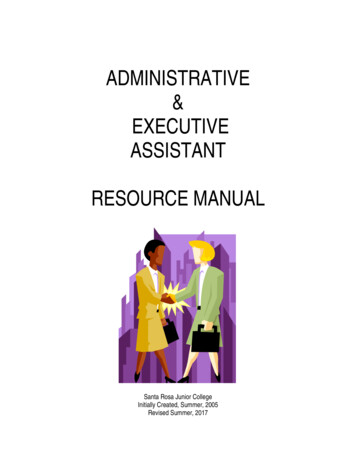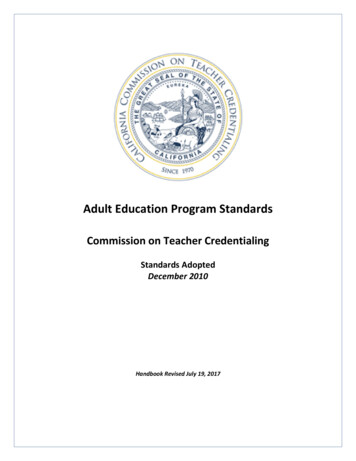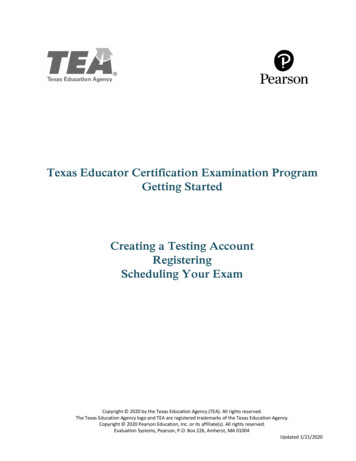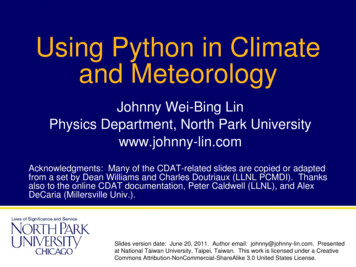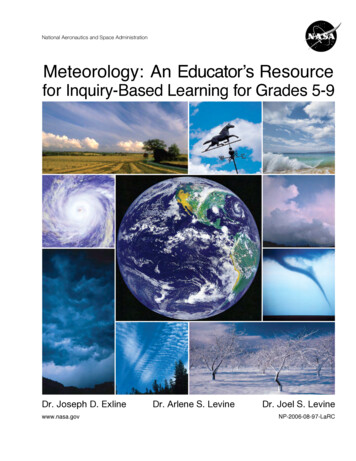
Transcription
National Aeronautics and Space AdministrationMeteorology: An Educator’s Resourcefor Inquiry-Based Learning for Grades 5-9Dr. Joseph D. Exlinewww.nasa.govDr. Arlene S. LevineDr. Joel S. LevineNP-2006-08-97-LaRC
Meteorology: An Educator’s Resourcefor Inquiry-Based Learning for Grades 5-9Dr. Joseph D. ExlineDr. Arlene S. LevineDr. Joel S. Levine
ContentsHow to Use This Guide .vAcknowledgements . viChapter 1: IntroductionAn Historical Look .Equipment and Supplies .Development of the Learning Philosophy to Science Education .Levels of Inquiry in Activities .1223Chapter 2: Weather and ClimateThe Structure of the Atmosphere . 5The Chemical Composition of the Atmosphere . 6Instruments to Measure Weather . 6Solar Radiation, the Greenhouse Effect and the Temperature of the Earth . 7Solar Heating and Atmospheric Motion . 8Cyclones and Anticyclones . 8Variations in Surface Atmospheric Pressure . 9Air Masses and Fronts . 9General Circulation of the Atmosphere . 10The Water Cycle and Clouds . 12Chapter 3: Surface Color and Effect of Temperature Change. 15Chapter 4: Angle of Light Rays and Surface Distribution . 19Chapter 5: Barometer Basics . 23Chapter 6: Constructing a Barometer . 27Chapter 7: Does Air Have Weight? . 31Chapter 8: Can You Show That the Temperature of Air Has an Effect on Its Weightand Its Direction of Vertical Movement? . 35Chapter 9: Are Cold Liquids More Dense Than Warm Liquids? . 39Chapter 10: Does Air Contain Water Vapor? . 43Chapter 11: A Sling Psychrometer and Relative Humidity . 47Meteorology Activities for Grades 5-9iNP-2006-08-97-LaRC
Chapter 12: How Clouds Form — Understanding the Basic Principles of Precipitation . 51Chapter 13: Tornado in a Box . 55Is There a Relationship Between Surface Heating (Temperature)and the Formation of a Low-Pressure System? . 56Is There a Relationship Between Surface Heating (Temperature)and the Formation of and Duration of a Low-Pressure System? . 59Is There a Relationship Between Surface Heating (Temperature) and the Duration ofa Low-Pressure System Based Upon Different Amounts of Water? . 62Develop a Testable Question and Design an Investigation That WillProvide Valid Information Regarding Factors That Affect the Formationand Duration of a Model Cloud Using the TIB Apparatus: . 65Chapter 14: Design Challenge: What Factors Determine the Comfort Level of Air? . 69Chapter 15: Bringing More Meaning to Weather Predicting:the Weather Station and “Reading” the Sky Help Put It All Together . 71Chapter 16: Predicting Weather by Connecting the Basic Cloud TypesWith Information Collected from the Weather Station . 77References . 81Meteorology Activities for Grades 5-9iiNP-2006-08-97-LaRC
AppendicesISuggestions for Maximizing the Use of Learner-Designed Activities. 85IISelected Weather Adages . 89IIIThe Scientific Habits of Mind and Conceptual Themes Addressed in This Publication . 91IVScience and Technology National Science Education Standards Addressed in This Publication. 93VWeb Sites for Enhancing the Understanding of Weather. 95VIConstructing Equipment . 103How to Build a Flashlight Holder . 103How to Build a Tornado in a Box . 105VIIAdditional Activities . 107Cloud Wheel. 109The Mysterious Snake . 113How Often Should I Measure the Weather? . 115VIIIBeaufort Scale of Wind Speed . 121IXThe Saffir-Simpson Hurricane Scale. 125XThe Fujita Scale for Tornado Damage . 129XIBookmarks . 131About the Authors. 133Meteorology Activities for Grades 5-9iiiNP-2006-08-97-LaRC
Meteorology Activities for Grades 5-9ivNP-2006-08-97-LaRC
How to Use This GuideMeteorology: An Educator’s Resource for Inquiry-Based Learning for Grades 5-9 is written as a supplement toexisting Earth and space science curricula for grades 5-9. The guide may be used in both formal and informaleducational settings as well as at home. It should be used in conjunction with lectures, discussions, textbooksand other teaching material. This guide is not intended to be a complete course in meteorology; rather, itsfunction is to assist educators in instilling excitement in learning about meteorology by permitting the learner totake increasing responsibility for his/her learning. The learner should experience “how we arrive at what weknow,” rather than memorizing what we know. This publication was developed to enhance the understanding ofinquiry-based learning from the educator/teacher’s perspective as well as from the learner’s perspective.Inquiry-based learning has many levels. In general, inexperienced learners and younger learners will requiremore guidance than more-experienced and older learners who are better equipped to take responsibility for theirlearning. There are four levels of inquiry defined in this publication, confirmation-verification, structuredinquiry, guided inquiry and open inquiry. The levels will be further defined and explained in the introductorychapter.The guide is structured to include a short review of some principles of meteorology and facts so that they maybe readily available to the educator. The Weather and Climate chapter (Chapter 2) is not intended to be used asan all-inclusive textbook, but rather an educator’s guide to some of the phenomena explored in this publication.Many activities offered in this guide build upon each other and use the inquiry in the previous activity to assistin the activity that follows. Thus, this publication enhances the understanding of meteorology by beginning withbasic and essential parameters of weather and then moving through mind-engaging interactions with complexmeteorological systems. The “Think About This!,” “Probing Further,” and “Examining Results” sections areprovided as examples to the educators; they may be used to stimulate the students to organize their thoughts in aparticular direction. Educators may use their own creativity in stimulating student inquiry. Further educatorinformation concerning these sections can be found in Appendix I: Suggestions For Maximizing The Use ofLearner-Designed Activities.The learner is encouraged to build and/or test a variety of weather instruments to better understand the basicfactors involved in weather phenomena. The weather instruments are then brought together to form a weatherstation. Collecting weather information combined with existing information about cloud systems allows thelearner to apply the knowledge to predict weather systems. Supplementary information and activities, which arenot inquiry-based, but deemed useful by the authors, are included in the appendices, including careerinformation Web sites in Appendix V.An interactive video game, entitled “The Hurricane Hunters,” is the second part of this project. NightlightStudios and the authors of this guide developed the game, which should be the culminating experience inlearning about meteorology as the learner has the opportunity to better understand the dynamics of hurricanes.Meteorology Activities for Grades 5-9vNP-2006-08-97-LaRC
AcknowledgementsThe authors thank John Pickle for his contribution in Appendix VII: How Often Should I Measure the Weather?;Erik Salna, of Hurricane Warning’s Disaster Survival House, for his contribution to Appendix IX; and Ron Girdand Dennis Cain of the NOAA National Weather Service for their support and contributions to this guide.We gratefully acknowledge Dr. Tina Cartwright, West Virginia State Climatologist, Marshall University; BethanyGordel, Gene Pike Middle School, Justin, Texas; and Carol Laird, Long Beach Island Grade School, ShipBottom, New Jersey, for their reviews and constructive comments on an early draft of this publication, as well asthe comments and reviews from the unnamed reviewers for the NASA product reviews; Denise M. Stefula,Science Systems & Applications, NASA Langley Research Center, for technical editing; and Richard E. Davis ofthe Systems Engineering Directorate, NASA Langley Research Center, for detailed review and refinementsincorporated in the final version of this document.We thank Dr. Lelia Vann, Director of the Science Directorate at NASA Langley Research Center and Dr. MingYing Wei, Program Manager for the Science Mission Directorate, NASA Headquarters, for their continuingsupport and enthusiasm for this project.The authors are very grateful to Anne C. Rhodes, NCI Information Systems, NASA Langley Research Center,for outstanding work and meticulous care in the graphical design, editing and general organization of this guide.Dr. Joseph D. ExlineDr. Arlene S. Levine*Dr. Joel S. Levine* Telephone: 757-864-3318E-mail: arlene.s.levine@nasa.govMeteorology Activities for Grades 5-9viNP-2006-08-97-LaRC
Chapter 1. IntroductionAn Historical LookThe following are old adages that relate to weatherchanges:Meteorology isone of the oldestobservationalsciences inhuman historyand perhaps themost relevant toa broad segmentof society. Someof our first observational meteorologists and weatherforecasters were shepherds, farmers and sailors whoselivelihoods and safety depended upon understandingand predicting the weather. Red sky at night,sailors’ delight. Red sky inmorning, sailorstake warning. Aches in bonesand joints indicatechanges in theweather. Wind that causes leaves to turn upward on treesindicates the coming of weather changes.Shepherds guarding their flocks on the ancient hillsides looked skyward for signs of changes in theweather. Farmers noticed that rain or drought coulddestroy crops if they were planted or harvested at thewrong time. Sailors experienced severe storms at seaor long delays if they were “trapped” in areas of calm.These groups gathered data through keen observations, which proved important as a foundationaldatabase of weather information. Lack of dew on the grass in early morningindicates changing weather. A circle around the moon indicates impendingprecipitation.Can these adages be explained scientifically? Canthey become crude weather predictors? Perhaps afteran in-depth examination of some of the weather activities included in this booklet, these statements can bereexamined. Additional weather adages may be addedto this list. See Appendices II and V for more adages.Ask your students to think of others.Questions for the Students: Can you think of waysthat weather changes affect activities and events inmodern society? Do you think weather has importantconsequences for most people in modern society?Why? Why not?Meteorology Activities for Grades 5-91NP-2006-08-97-LaRC
Equipment and Supplies NecessaryTo Conduct the ActivitiesDevelopment of the Learning Philosophyto Science EducationWe understand that many schools may not have thesupplies and equipment necessary to conduct costlymeteorology experiments and activities, so this publication focuses on activities using common materialspeople can find in the home or in local stores. It is important to note that we have included only one way toconstruct instruments; the educator may have alternative methods, which may work as efficiently and areless costly. The authors make these instrument construction suggestions as a starting point for educators.Staff members who work in well-equipped schoolsmay substitute commercially available equipment andsupplies. However, there are pedagogical advantagesto constructing the equipment. Constructing theequipment may lead to a better understanding of thephenomenon measured and how the equipmentworks. The “Materials Needed” suggestions arebased on the activity; quantities required woulddepend upon how the students are grouped forconducting activities.For science education to have meaning for all students, there should be a strong focus on the essentialelements of inquiry learning, which are described inthe National Science Education Standards (NSES)and the American Association for the Advancementof Science (AAAS) Benchmarks. Using these documents as a foundation, the Council of State ScienceSupervisors (CS3), through the CS3/NASA NLISTInitiative, developed an operational definition ofScience as Inquiry (www.nlistinquiryscience.com).It is extremely important that teachers advise studentsabout safety considerations when conducting scienceactivities. Educators must exert judgment as to thematurity level required for the students to carry outsome of the activities independently. As an example,can the students, wearing protective heatproof glovesand safety glasses, handle the boiling water, or shouldthe educator handle the waterwith the students at a safedistance? The samequestion applies to thesling psychrometer,Are the students matureenough to sling thepsychrometer, or shouldthe educator sling it at asafe distance from thestudents? Learning set in a broad context (concepts) canenable deeper understanding and enhance thetransfer of knowledge to new and different situations (Appendix III).Meteorology Activities for Grades 5-9The operational definition of science as inquiry promulgated by the CS3/NASA NLIST Initiative consists of these essential elements: (1) conceptual context for science content; (2) relevant and importantscience content; (3) information-processing skills;and (4) the scientific habits of mind (approaches).These essential elements should become the focusof material development. They enhance the relevancyand applicability of science knowledge. Content then becomes a building block for constructing and comprehending important concepts. Skill development becomes the means forcontinuing the generation of new knowledge. Habits of mind (approaches) employed by expertsand nurtured in learners can ensure the integrityof the discipline and provide a valid world viewfrom the perspective of science (Appendix III).These essential elements, brought together holistically in a learning environment, make science bothrelevant and applicable for all learners. Furthermore,this approach enables the development of skills andapproaches needed to continue lifelong learning.2NP-2006-08-97-LaRC
Levels of Inquiry in ActivitiesThe skills scientists use and the scientific approach,which are the foundation of generating a body ofscientific knowledge, are often overlooked in scienceeducation. Science education is still taught andlearned as a history lesson — with a focus on “this iswhat we know.” If educators emphasize “how weknow,” students will develop skills and acquirescientific attitudes that yield a valid scientific view ofthe world and the ability to use these skills as a lifelong way of resolving problems. Many activities usedto teach science are mindless “hands on” lessons anddo not engage a “minds on” response. Capable students can see the activity outcomes without goingthrough the procedures and are not challenged. Manyeducators think inquiry learning takes place onlythrough student activities. Teacher demonstrations,classroom discussions, and even lectures can encourage the development of the essential elementsof inquiry if the focus is on “how we come aboutknowing” rather than on “this is what we know.”Just as children move through a series of stages whenlearning to walk, programs designed for science education should consider important developmentalstages in moving learners toward taking charge oftheir own learning. The programs should have effective experiences that will enable learners to movefrom receivers of information to pursuers of knowledge. Young learners and less-experienced learnersneed more direction and “hand holding,” but as theymature and increase their abilities, they need moresophisticated challenges. There should be a gradualshift in the help given students as they move to theupper levels of schooling, even during the later stagesin a course.Scientists approach the generation of knowledgedifferently than the way schools provide learnersaccess to this knowledge. Experts start with observations, pose questions, and at some point frame acontext for these questions. Depending upon thediscipline, they apply the ground rules or approachesto a particular discipline. Experts make “wrong turns”or reach “dead ends” and often must rework approaches to get resolutions to questions. Using theseskills and applying the ground rules of the disciplineenables experts to improve the learners’ abilities toresolve problems. With this emphasis on learning, thestudent develops a more valid view of the scientificprocess and can better see the world through the lensof a particular discipline.There are four levels of activities that can be classified according to levels of inquiry potential. Whileany of these inquiry levels can be appropriate for alllevels of learners, it is expected that the morestructured learning experiences lie at lower gradelevels and the more open-ended and less-structuredones predominate as students approach high schoolgraduation. The following classification is modifiedfrom the work of Herron (1971) and his efforts todevelop a simple, practical rubric for assessing thedegree to which activities promote student inquiry.Based partly on the writings of Schwab (1964),Herron describes four levels of inquiry. The subsequent classification is a slight modification in looking at a teacher-centered approach versus a shifttoward a more learner-centered approach.AN IMPORTANT NOTE: For teachers who needa more traditional correlation with the national standards and benchmarks that put greater emphasis uponcontent correlation, see Appendix IV. This type ofcorrelation does not negate the important educationalapproach outlined previously but helps to illustratethat this publication’s approach considers the demands on teachers in current classrooms.Meteorology Activities for Grades 5-93NP-2006-08-97-LaRC
(3) Guided inquiry. Students investigate a teacherpresented question using their own procedures forconducting the activity. The value of this level ofactivity is in challenging learners to design theprocedure that will produce appropriate data tovalidly resolve the question. Further, the learner hasan additional opportunity to learn from the teacherpresented testable question.(4) Open inquiry. Students investigate a topic-relatedquestion that they have formulated. They are responsible for defining a manageable question(s), designingprocedures to collect, record, and evaluate data, anddraw interpretations, inferences, and conclusions. Inthis level of activity, the student benefits from learning how to design a testable question and also todesign a procedure to generate the data necessary toappropriately resolve the question. The teacher ensures that the student addresses the concepts beingstudied by framing a context in a broad nontestablestatement, such as, “Investigate an aspect about whatcauses air movement within Earth’s atmosphere.” It isthen necessary for the learner to carve out a piece orpieces of this statement that can be tested.Throughout this publication the learner will have theopportunity to experience activities that representeach of the four levels. Furthermore, these activitieswill be specifically identified as to the predominantinquiry level of the particular activity. This identification will assist the educator in better understandinginquiry levels and how to select or develop moreactivities that address these various inquiry levels.(1) Confirmation-verification. Students confirm orverify a concept through both a prescribed questionand procedure; the results are known in advance.The value of this level of activity is in introducingstudents, who have had very little or no experiencein performing science activities, to the general stepsin the design of investigations.NOTE: It should be understood that any of theseinquiry levels of activities can provide educationalbenefit. However, it is important to challenge thelearner to take more responsibility for his/herlearning. After working through these activitieswith students, the teacher will also have a betterunderstanding of ways to modify these levels ofactivities to suit the needs of various learners.(2) Structured inquiry. Students investigate ateacher-presented testable question through a prescribed procedure. The results of the investigationare not known in advance, and students generalizerelationships by using the outcomes of the activity.The value of this level of activity is to challenge thelearner to examine the data and to come to a validconclusion based upon these data. It also gives thelearner further experience with the concept of a“testable” question and investigative design structure.Meteorology Activities for Grades 5-94NP-2006-08-97-LaRC
Chapter 2. Weather and ClimateThe Structure of the AtmosphereWhile the Earth’s atmosphere extends upward forhundreds of kilometers until it merges with interplanetary space, more than half of the atmosphere’s totalmass is below an altitude of only about 6 kilometers(3.75 miles) above the surface (Figure 2-1). Thelowest region of the atmosphere, the troposphere,extends from the surface to an altitude that varies from10 to 15 kilometers (km) (6.2 to 9.3 miles (mi.)),depending on latitude and season. The top of thetroposphere is called the tropopause. The regions ofthe atmosphere above the troposphere are thestratosphere (from between 10 and 15 to 40 km(between 6.2-9.3 and 25 mi.)), the mesosphere (40 to80 km (25 to 50 mi.)), the thermosphere (80 to 500 km(50 to 310 mi.)) and the exosphere (begins at about500 km (310 mi.)). The exosphere merges withinterplanetary space. The ionosphere is the region ofatmosphere between 40 and 300 km (25 and 185 mi.).It is the region of positively-charged atoms andmolecules and negatively-charged electrons.Surrounding the Earth is a gaseous envelope oratmosphere, held in place by the planet’s gravitationalattraction. The Earth’satmosphere is a complexdynamical, physical, andchemical system. Dynamic processes cover alarge range of scales fromthe microscopic-scaledynamics of evaporation,condensation, cloudformation and precipitation, to small-scale,localized vertical andhorizontal wind motions,to medium-scalecyclones, anticyclones,hurricanes, typhoons,tornadoes, thunderstorms,fronts, etc., to the largescale general circulationof the atmosphere.Physical processes in the atmosphere include thetransfer of incoming solar radiation through theatmosphere to the surface, the heating of the surface,the emission of outgoing infrared radiation, theabsorption of infrared radiation by atmospheric gases,the evaporation of water, the condensation of atmospheric water vapor into clouds, and precipitation.Chemical processes include the transformation andproduction of atmospheric gases, such as atmosphericozone, via chemical reactions involving many dozensof gases in the atmosphere.Meteorology Activities for Grades 5-9Figure 2-1. Regions of the atmosphere.5NP-2006-08-97-LaRC
The Chemical Compositionof the AtmosphereInstruments to Measure WeatherWeather is the instantaneous or current state of theatmosphere and is measurable in terms of temperature, atmospheric pressure, humidity, wind speed anddirection, cloudiness and precipitation. Climate is thestate of the atmosphere over long time periods, suchas over years, decades, centuries or greater. In general, the weather that impacts the surface of the Earthand those that live on the surface takes place in thetroposphere. Weather parameters are measured withdifferent instruments. Atmospheric temperature ismeasured with a thermometer.The Earth’s atmosphere is a complex mixture ofgases: nitrogen (N2) (about 78% by volume), oxygen(O2) (about 21% by volume) and argon (Ar) (about0.9% by volume) with small and varying amounts ofwater vapor (H2O) (0 to 4% by volume) and stillsmaller amounts of carbon dioxide (CO2), methane(CH4), nitrous oxide (N2O), ozone (O3) and dozens ofother gases at still smaller concentrations. The chemical composition of the atmosphere is given in Table2-1. The protection afforded by the atmosphere isvery important for life on Earth. The atmosphereshields the Earth’s surface and its myriad forms oflife from biologically damaging high-energy cosmicradiation. In addition, ozone, found mostly in thestratosphere, absorbs ultraviolet radiation from theSun, shielding the Earth’s surface from this biologically damaging radiation.Atmospheric pressure is a measure of the forceexerted by the mass of atmosphere on the surface ata given location. The average pressure of the atmosphere at mean sea level is about 1 kg per square cm,which is equivalent to about 14.7 pounds per squareinch or a pressure of 1013.25 millibars (mb), andwhich is also referred to as 1 atmosphere. Atmospheric pressure is measured with a barometer.Table 2-1. Chemical Compositionof the Earth’s AtmosphereGasNitrogen (N2)Concentration*78.084%Oxygen (O2)20.946%Argon (Ar)0.934%Carbon Dioxide (CO2)0.037%Water Vapor (H2O)0.01 to 4%†Neon (Ne)18.2 ppmvHelium (He)5.0 ppmvMethane (CH4)1.8 ppmvKrypton (Kr)1.1 ppmvHydrogen (H2)0.5 ppmvNitrous Oxide (N2O)0.5 ppmvXenon (Xe)0.09 ppmvOzone (O3)0.0 to 0.07 ppmv†Nitrogen Dioxide (NO2)Humidity is a general term that refers to the watervapor content of the air. Absolute humidity is theactual amount of water vapor per volume of air.Relative humidity is the percentage of water vaporin the atmosphere compared with
an all-inclusive textbook, but rather an educator’s guide to some of the phenomena explored in this publication. Many activities offered in this guide build upon each other and use the inquiry in the previous activity to assist in the activity that follows. Thus, this publication en
